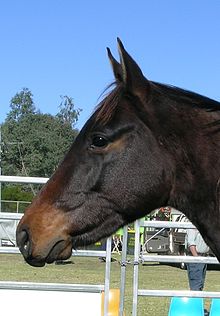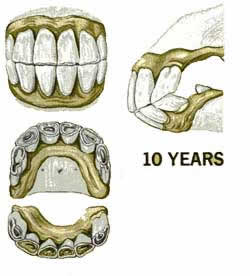A friend of mine poked me on facebook asking about malocclusion in horses. Frankly speaking this is my first time to read the word. I did not know anything about equine dentistry, but maybe I can learn something while googling this info. Thanks Azamin :)
**************************************************************
Malocclusion in horse
An equine malocclusion is a misalignment between the upper and lower jaws of a horse or other equine. It results in a faulty bite with the upper and lower teeth failing to meet correctly. Malocclusions can cause pain to the horse and may also lead to weight loss and other eating problems related to poor chewing or loss of appetite especially in ageing horse.
It is also known as the inability of the arcades of molars or incisors to occlude, fit together properly or work effectively/efficiently.

Parrot jaw

Normal presentation of teeth of 10 years old horse
MOLARS
1. Caudal hooks

Etiology - Hereditary - May result from horse born with over or under bite.
Developmental - May result secondary to molar malocclusion that forces jaw out of alignment.
Resulting Problems - prevents horse from chewing freely side to side resulting improper and excessive molar wear. Tight soft tissues are very susceptible to lacerations from sharp molar points. Can cause extreme discomfort as head carriage or frame is changed when riding.
Solution - Reduce dominant molar to prevent excessive wear to opposing molar and carefully round to prevent soft tissue trauma.
2. Rostral hooks

Definition - Dominant upper front premolars overhang lower premolars.
Etiology - Hereditary - May result from horse born with an overbite.
Developmental - May result secondary to molar malocclusion that forces jaw out of alignment.
Resulting Problems - Prevents horse from chewing freely side to side resulting in improper and excessive molar wear. Can cause excessive wear to opposing lower premolar. Can cause severe bit problems and trauma to soft tissue.
Solution - Reduce dominant portion of upper premolar, rounding unopposed portion of premolar smoothly toward gum. Requires preventative maintenance to prevent reoccurrence.
3. Ramps

Etiology - May occur when upper from premolar deciduous cap, or baby tooth is retained preventing normal growth of permanent premolar. Can occur if a tooth is reduced without corresponding correction to opposing tooth.
Resulting Problem - Prevents horse from chewing freely side to side resulting in improper and excessive molar wear. Can cause severe discomfort with the bit. Can force lower jaw forward over time causing under bite.
4. Enamel points

Definition - sharp points that generally form on the outside of the upper molars and the inside of the lower molars.
Etiology - Occurs over time as horse stops chewing as far sideways resulting in unopposed edge tooth getting longer and the enamel forms razor sharp points.
Resulting Problem - Enamel points traumatize soft tissues causing pain and discomfort when eating and also from bits and other head gear pulling cheeks and tongue into these areas. Also stops horse from chewing freely sideways.
Solution - Remove sharp enamel points.
5. Sheared molar table

Definition - Extreme angulation of chewing surface of molars.
Etiology - Results from lack of lateral excursion or side to side chewing.
Resulting Problems - Very severe problem. Does not allow horse to chew sideways resulting in very poor utilization of feed.
Solution - Correct molar table angle of upper and lower molars over time allow horse freedom to chew side to side.
6. Wave complexes


Definition - Molar arcade develops an uneven "wavelike" appearance generally involving many premolars and molars.
Etiology - Often occurs secondary to other malocclusions such as retained deciduous caps, missing teeth, hooks, ramps, etc. Results from horse being unable to obtain free side to side chewing.
Resulting Problems - Causes gradual excessive wear to many molars, resulting in prematurely worn out teeth, periodontal pocketing, decay and loss of teeth. Prevents free side to side chewing and inhibits proper grinding of feed.
Solution - Reduce high complexes to allow recovery of opposing teeth and allow freedom to chew freely side to side to encourage proper use. Requires preventative maintenance over time.
7. Stepped molars

Definition - Molar arcade develops stepped-like appearance.
Etiology - Most often occurs due to a missing tooth allowing the opposing tooth to grow into the void. Can occur from extreme uneven wear. May occur when a deciduous cap or baby tooth is retained too long delaying normal growth of permanent tooth and allowing opposing tooth to grow too long.
Resulting Problems - Prevents or blocks the horse from being able to chew freely resulting in uneven and improper wear to molars and incisors.
Solution - Reduce high molar to allow freedom to chew correctly. Requires maintenance to prevent unopposed tooth from growing into space.
8. Accentuated transverse ridges

Definition - Enlarged ridges that run across chewing surfaces of molars.
Etiology - Can result from a shift in jaw alignment. Forms from a harder area in one tooth over powering and wearing into a soft area in an opposing tooth. also can occur if horse is not chewing in proper sideways motion.
Resulting Problems - Interfere with normal chewing and jaw motion front to back. Cause excessive wear to opposing molars. Can result in severe periodontal disease and diastema.
Solution - Reduce enlarged ridges to allow opposing teeth to recover and horse to chew correctly. Will improve when existing malocclusions are corrected.
9. Periodontal pockets

Definition - Gum disease around tooth causing an area for feed to pocket.
Etiology - Results from malocclusion or misalignment of teeth. Progresses as horse is unable to chew correctly.
Resulting Problem - Gum disease leads to bone erosion around teeth and eventually can cause infection, abscess and loss of tooth.
Solution - Correct malocclusion as early as possible. Very difficult to stop progression of periodontal disease if it is not stopped early on. Prevention is the key.
9. Diastema

Definition - Space that occurs between two adjoining teeth.
Etiology - Often results as malocclusions force two teeth apart over time.
Resulting Problems - Causes feed to get trapped between teeth resulting in progressive and severe periodontal disease. Results in overall poor oral health.
Solution - Very difficult to correct. Reduce unopposed overgrowth of opposing teeth. Prevention of malocclusions in th key.
INCISORS
1. Overbite

Definition - Upper incisors protrude in front of lower incisors.
Etiology - Hereditary - Horse may be born with an overbite. This will often result in rostral and/or caudal hooks. Developmental - Rostral and/or caudal hooks can shift alignment of bite resulting in an overbite.
Resulting Problem - Prevents horse from chewing freely side to side resulting in improper and excessive molar wear. Rostral and caudal hooks, transverse ridges, wave complexes and sheared molar table angles will become more severe as the horse is forced to chew incorrectly over time. Can also cause severe discomfort with the bit.
Solution - Reduce length of upper incisors. Correct molar malocclusions.
2. Underbite

Definition - Lower incisors protrude in the front of upper incisors.
Etiology - Hereditary - Horse is born with under bite. Developmental - Ramps on lower premolars can cause lower jaw to shift forward resulting in an under bite.
Resulting Problems - Prevents horse from chewing freely side to side resulting in improper and excessive molar wear. Ramps, transverse ridges, wave complexes and sheared molar table angles will become more severe as horse is forced to chew incorrectly over time. Can also cause severe discomfort with the bit. Can result in TMJ pain.
Solution - Reduce length of lower incisors. Correct corresponding molar abnormalities.
3. Ventral curvature (smile)

Definition - Outer corner lower incisors grow longer relative to outer corner upper incisors.
Etiology - May occur when deciduous caps are rretained onupper corner incisors preventing normal growth of permanent incisors. Can occur due to abnormal chewing secondary to molar malocclusions.
Resulting Problems - Inhibits horse from chewing freely side to side often resulting in improper and excessive molar wear.
Solution - Reduce length of upper central incisors and lower corner incisors to allow free side to side movement.
4. Dorsal curvature (frown)

Definition - Outer corner upper incisors grow longer relative to outer corner lower incisors.
Etiology - May occur when deciduous caps are retained on lower corner incisors preventing normal growth of permanent incisors. Often occurs from cribbing and wwoodchewing and can occur due to abnormal chewing secondary to molar malocclusions.
Resulting Problems - Inhibits horse from chewing freely side to side often resulting in improper and excessive molar wear.
Solution - Reduce length of upper corner and lower central incisors to allow free side to side movement.
5. Offset or diagonal bite

Definition - Upper incisors on one side of mouth are excessively long and lower incisors on opposite side are excessively long, causing incisors to meet on a diagonal.
Etiology - May develop over time if horse chews more in one direction. Can result from cribbing and wood chewing and may occur secondary to molar malocclusion or as a result of a missing incisor or incisor damage causing opposing incisors to become excessively long.
Resulting Problem - Causes horse to excessively wear molars on one side of mouth and opposite side molars become excessively long resulting in a sheared molar table angle. Can result in TMJ pain.
Solution - Reduce excessively long incisors. Correct corresponding molar mmalocclusions Will need frequent follow up corrections.
6. Bone spur

Definition - Mandibular periotitis or abnormal bony growth due to trauma.
Etiology - Most often caused by trauma from bit to lower jaw bone.
Resulting Problem - Can be extremely painful causing behavioral problems when bit contacts area.
Solution - Surgical removal of affected bone.
7. Wolf tooth

Definition - Small shallow rooted teeth in front of premolars. Most common in upper jaw. Can occasionally occur in front of lower premolars.
Etiology - A normal finding in most horses. May not appear in some horses.
Resulting Problem - Bit may contact tooth causing severe pain and discomfort as tooth moves. Can fracture or become loose causing discomfort
Solution - Wolf teeth should be removed before horse starts being bitted to prevent discomfort and bad habits.
8. Blind wolf tooth

Definition - Abnormal wolf tooth that does not break through gums.
Etiology - Blind Wolf Tooth usually comes in at an angle, often up to one inch forward of premolars. Angle of tooth does not allow it to penetrate gums.
Resulting Problem - Can cause severe bit problems. In a location that bit often contacts. Often missed due to being buried under gums.
Solution - Generally easy to surgically remove.
Source: Equine health from discerning hands equine dentistry; common equine dental malocclusions




























0 comments:
Post a Comment